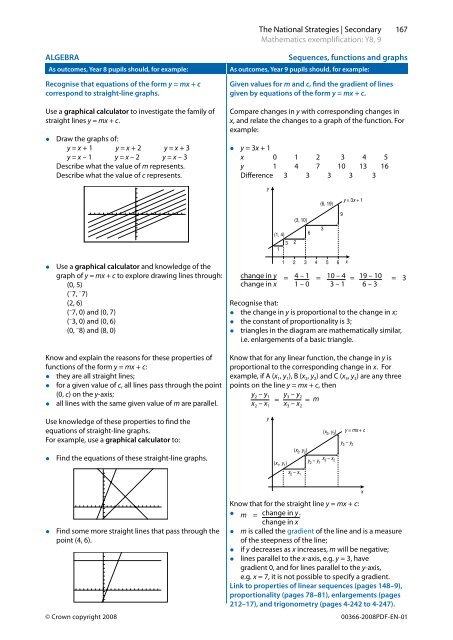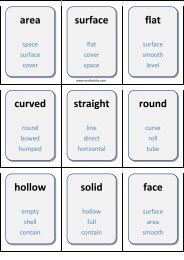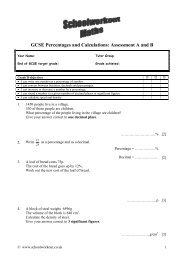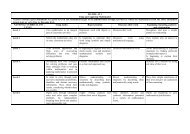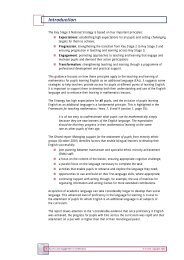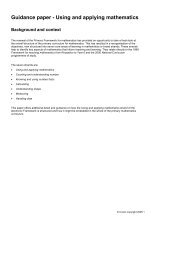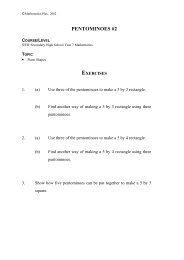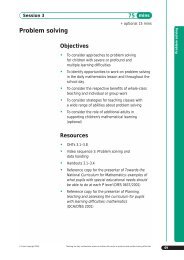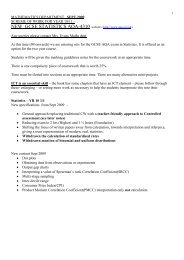ALGEBRA Equations, formulae, expressions and ... - Suffolk Maths
ALGEBRA Equations, formulae, expressions and ... - Suffolk Maths
ALGEBRA Equations, formulae, expressions and ... - Suffolk Maths
You also want an ePaper? Increase the reach of your titles
YUMPU automatically turns print PDFs into web optimized ePapers that Google loves.
The National Strategies | Secondary<br />
Mathematics exemplification: Y8, 9<br />
167<br />
<strong>ALGEBRA</strong><br />
As outcomes, Year 8 pupils should, for example:<br />
Recognise that equations of the form y = mx + c<br />
correspond to straight-line graphs.<br />
Use a graphical calculator to investigate the family of<br />
straight lines y = mx + c.<br />
• Draw the graphs of:<br />
y = x + 1 y = x + 2 y = x + 3<br />
y = x – 1 y = x – 2 y = x – 3<br />
Describe what the value of m represents.<br />
Describe what the value of c represents.<br />
Sequences, functions <strong>and</strong> graphs<br />
As outcomes, Year 9 pupils should, for example:<br />
Given values for m <strong>and</strong> c, find the gradient of lines<br />
given by equations of the form y = mx + c.<br />
Compare changes in y with corresponding changes in<br />
x, <strong>and</strong> relate the changes to a graph of the function. For<br />
example:<br />
• y = 3x + 1<br />
x 0 1 2 3 4 5<br />
y 1 4 7 10 13 16<br />
Difference 3 3 3 3 3<br />
y<br />
(6, 19)<br />
y = 3x + 1<br />
• Use a graphical calculator <strong>and</strong> knowledge of the<br />
graph of y = mx + c to explore drawing lines through:<br />
(0, 5)<br />
( – 7, – 7)<br />
(2, 6)<br />
( – 7, 0) <strong>and</strong> (0, 7)<br />
( – 3, 0) <strong>and</strong> (0, 6)<br />
(0, – 8) <strong>and</strong> (8, 0)<br />
Know <strong>and</strong> explain the reasons for these properties of<br />
functions of the form y = mx + c:<br />
they are all straight lines;<br />
• for a given value of c, all lines pass through the point<br />
(0, c) on the y-axis;<br />
• all lines with the same given value of m are parallel.<br />
Use knowledge of these properties to find the<br />
equations of straight-line graphs.<br />
For example, use a graphical calculator to:<br />
•<br />
Find the equations of these straight-line graphs.<br />
change in y = 4 – 1 = 10 – 4 = 19 – 10 = 3<br />
change in x 1 – 0 3 – 1 6 – 3<br />
Recognise that:<br />
the change in y is proportional to the change in x;<br />
the constant of proportionality is 3;<br />
• triangles in the diagram are mathematically similar,<br />
i.e. enlargements of a basic triangle.<br />
Know that for any linear function, the change in y is<br />
proportional to the corresponding change in x. For<br />
example, if A (x 1 , y 1 ), B (x 2 , y 2 ) <strong>and</strong> C (x 3 , y 3 ) are any three<br />
points on the line y = mx + c, then<br />
y 2 – y 1<br />
= y 3 – y 2<br />
= m<br />
x 2 – x 1 x 3 – x 2<br />
y<br />
(1, 4)<br />
1<br />
1<br />
3<br />
(x 1 , y 1 )<br />
(3, 10)<br />
2<br />
2<br />
3<br />
(x 2 , y 2 )<br />
6<br />
3<br />
4 5 6<br />
(x 3 , y 3 )<br />
9<br />
y2 – y 1<br />
y 3 – y 2<br />
x 2 – x 1<br />
x 3 – x 2<br />
x<br />
y = mx + c<br />
• Find some more straight lines that pass through the<br />
point (4, 6).<br />
Know that for the straight line y = mx + c:<br />
• m = change in y ;<br />
change in x<br />
• m is called the gradient of the line <strong>and</strong> is a measure<br />
of the steepness of the line;<br />
if y decreases as x increases, m will be negative;<br />
• lines parallel to the x-axis, e.g. y = 3, have<br />
gradient 0, <strong>and</strong> for lines parallel to the y-axis,<br />
e.g. x = 7, it is not possible to specify a gradient.<br />
Link to properties of linear sequences (pages 148–9),<br />
proportionality (pages 78–81), enlargements (pages<br />
212–17), <strong>and</strong> trigonometry (pages 4-242 to 4-247).<br />
© Crown copyright 2008 00366-2008PDF-EN-01<br />
x


